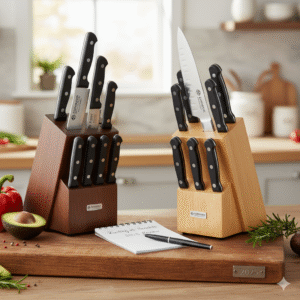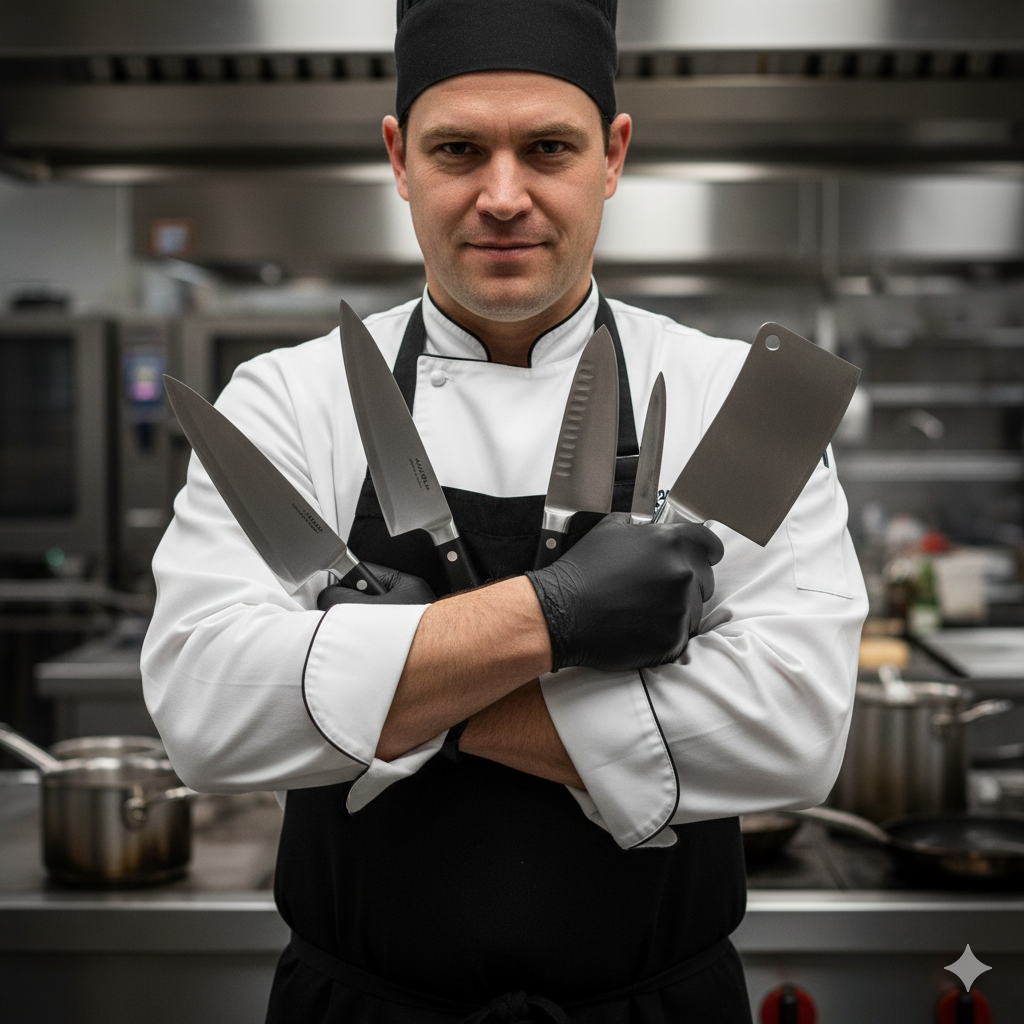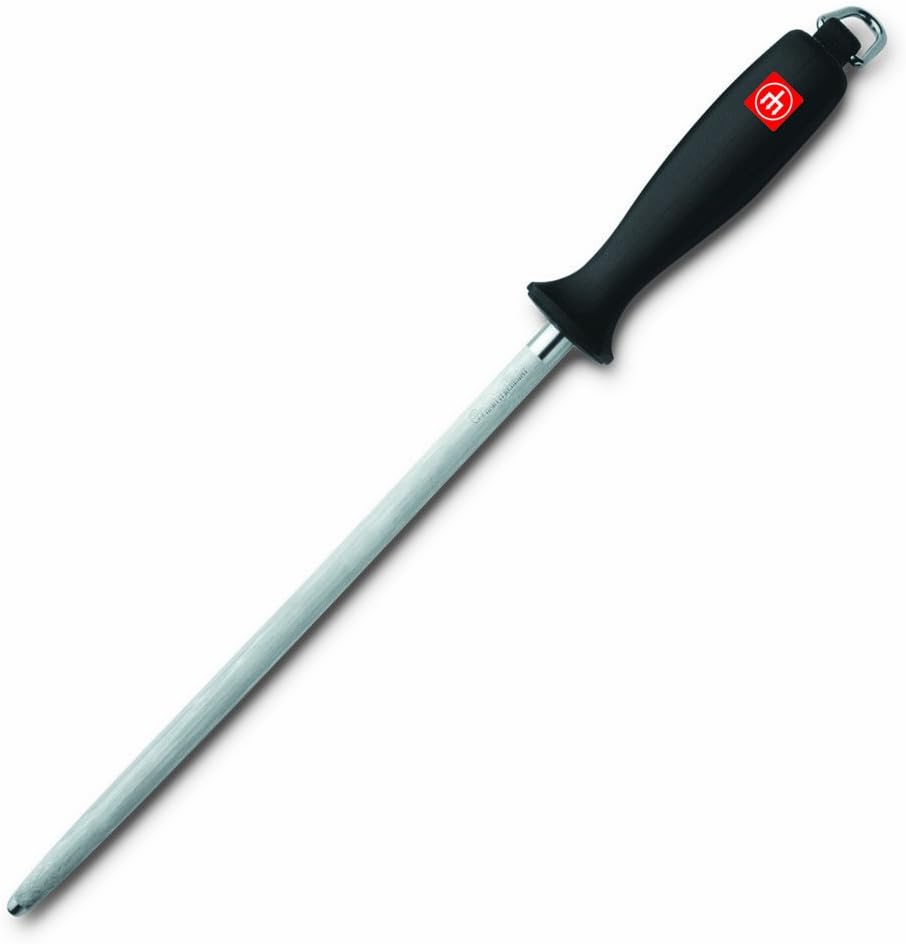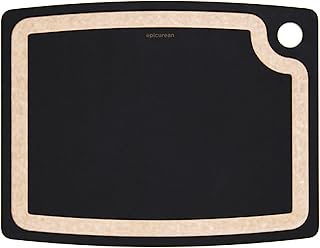Zwilling vs Henckels Knives: An In-Depth Comparison (2025)
Walk into any major kitchen supply store, and you’ll face a wall of German knives. Among them, two names dominate: Zwilling and Henckels. Their logos—one with two figures, one with a single figure—look strikingly similar. This leads to one of the most common questions I hear: Are they the same company? And if so, which one should I actually buy? After years of using both in my own kitchen, I’m here to cut through the confusion and give you the definitive answer.
Affiliate Disclosure: This post contains affiliate links. This means if you make a purchase through my links, I may earn a commission at no extra cost to you. I only recommend products I have personally used and trust. My goal is to provide honest, experience-based advice to help you find the perfect knives for your kitchen.
The Short Answer (TL;DR)
Don’t have time for a 4,000-word deep dive? Here’s the bottom line:
- Yes, they are the same parent company. The German company Zwilling J.A. Henckels makes both brands.
- Zwilling is the premium, top-tier brand. These are high-performance knives, primarily forged in Solingen, Germany, using high-carbon steel. They are aimed at serious home cooks and professionals.
- Henckels (or Henckels International) is the value-focused, entry-level brand. These knives are designed to be affordable and accessible, often manufactured outside of Germany (e.g., Spain, China, India) with slightly softer steel and simpler construction.
Think of it like Toyota and Lexus. Toyota makes reliable, affordable cars for everyone (Henckels). Lexus is their premium, luxury brand with higher performance and a bigger price tag (Zwilling).
The Core Confusion: One Company, Two Brands
Let’s clear this up right away. The parent company, founded in 1731 in Solingen, Germany, is Zwilling J.A. Henckels. Over the centuries, as they expanded globally, they realized the need for two distinct product tiers to serve different markets. This led to the creation of Henckels International.
A Tale of Two Logos: The “Twins” vs. The “Stick Figure”
The easiest way to tell them apart on a store shelf is the logo stamped on the blade.
- ZWILLING (The “Twins”): This logo features two stylized figures. It signifies the premium, German-made line. If you see the twins, you’re looking at the company’s flagship product.
- HENCKELS (The “Stick Figure”): This logo features a single stylized figure. It denotes the more affordable, internationally-made value brand.
This simple visual cue is your first and most reliable indicator of the knife’s quality, origin, and price point. Now, let’s break down what those differences really mean for you in the kitchen.
Deep Dive: Zwilling vs. Henckels Feature Comparison
1. Manufacturing Origin & Philosophy: The Soul of the Steel
Where a knife is made tells you a lot about its heritage and intended quality.
Zwilling: German Engineering in Solingen
Zwilling knives are, with very few exceptions, manufactured in their legendary factory in Solingen, Germany. This city is known as the “City of Blades” and has a reputation for steel craftsmanship protected by law, similar to Champagne in France. A knife stamped “Solingen” must meet strict quality standards. This German heritage means a focus on precision, durability, and a “buy it for life” mentality. The entire process, from forging to finishing, is a matter of national pride.
Henckels: A Global Approach to Value
Henckels knives are made all over the world. While the design and quality control are overseen by the German parent company, the actual manufacturing is often done in countries with lower production costs, such as Spain, India, and China. This global approach is key to their strategy: delivering a reliable, functional knife at a price point that’s accessible to everyone, from college students to new homeowners.
2. Steel Quality & Blade Construction: The Heart of Performance
The type of steel used and how it’s treated is arguably the most important factor in a knife’s performance. This is where the price difference between the two brands is most justified.
Zwilling: Proprietary High-Carbon Steel
Zwilling uses a proprietary high-carbon, no-stain stainless steel formula in their German-made knives. They subject this steel to their signature FRIODUR® ice-hardening process. This involves heating the steel to extreme temperatures and then cryo-freezing it. This complex process refines the steel’s molecular structure, resulting in a blade that is:
- Harder: Typically around 57 Rockwell Hardness (HRC). This allows for a sharper, more acute edge angle (around 15° per side).
- More Durable: The refined structure makes the blade more resistant to chipping and corrosion.
- Better Edge Retention: A harder blade holds its sharp edge for significantly longer, meaning less frequent sharpening.
This superior steel is a core reason why many home chefs and professionals consider them among the best chef knife brands available.
Henckels: Reliable Stainless Steel
Henckels uses quality stainless steel sourced from their international factories. It’s a good, reliable steel that is tough and highly resistant to rust. However, it’s generally a softer steel than what’s used in Zwilling knives (typically 54-56 HRC). A softer steel means:
- Easier to Sharpen: Softer steel is less resistant to abrasion, so you can bring a dull edge back to life very quickly with a simple sharpener or honing rod.
- Lower Edge Retention: The downside is that it will lose its razor-sharp edge more quickly, requiring more frequent honing and sharpening.
- Tougher, Less Brittle: Softer steel is less likely to chip if you accidentally hit a bone, making it very forgiving for beginners.
3. Forged vs. Stamped Blades: A Difference You Can Feel
This is a major construction difference that impacts a knife’s balance, weight, and durability.
Zwilling: Primarily Forged
Most premium Zwilling lines (like the Pro, Four Star, and Professional “S”) are forged. This means each blade is heated and hammered from a single, solid piece of steel. This process creates a thicker, heavier, and more robust knife. Key features of a forged knife include:
- A Bolster: The thick piece of metal between the blade and the handle. It adds weight, provides perfect balance, and acts as a finger guard for safety.
- A Full Tang: The steel from the blade runs all the way through the handle, providing superior strength and balance. You can usually see the metal sandwiched between the handle scales.
Henckels: Primarily Stamped
Most Henckels lines (like the popular Statement and Solution series) are stamped. The blades are cut out from a large sheet of steel, like a cookie-cutter. They are then heat-treated, sharpened, and attached to a handle. Stamped knives are:
- Lighter and Thinner: They are less fatiguing to use for long periods and can feel more nimble.
- No Bolster: The blade runs straight into the handle, making them lighter but offering less balance and no finger protection.
- Partial Tang: The tang usually only extends partway into the handle, which is sufficient for most home tasks but less robust than a full tang.
Note: There are exceptions! Henckels does produce some excellent forged lines, like the Henckels Classic, which offer a fantastic bridge between the two brands’ typical styles.
Head-to-Head: Popular Knife Lines Reviewed
Let’s move from theory to practice. I’ve spent countless hours with these knives, and here’s my breakdown of some of the most popular lines from each brand you can find on Amazon.
Top Pick from Zwilling: Zwilling Pro 8-inch Chef’s Knife

The Professional’s Choice at Home
This is, in my opinion, the pinnacle of Zwilling’s design. The Pro line is forged from high-carbon German steel and features a unique curved bolster. This design encourages a proper “pinch grip,” making the knife feel like a natural extension of your hand. It’s perfectly balanced, incredibly sharp out of the box, and holds its edge for a very long time. Dicing an onion is effortless; the blade glides through without any wedging. It’s a true workhorse.
Pros
- Exceptional balance and ergonomics
- Curved bolster promotes a perfect grip
- Incredibly sharp and holds its edge
- Forged in Germany for maximum durability
Cons
- Premium price point
- Can feel heavy for some users
Best Value from Zwilling: Zwilling Four Star 8-inch Chef’s Knife

The Timeless Classic
The Four Star line has been a bestseller for over 40 years for a reason. It features the same German-forged, ice-hardened blade as the Pro line but has a simpler, molded synthetic handle and a standard bolster. This makes it slightly lighter and more affordable. It’s an incredibly comfortable and reliable knife that offers 90% of the Pro’s performance for a lower price. It’s a fantastic entry point into the world of premium German cutlery.
Pros
- Same high-quality blade as premium lines
- Comfortable and secure molded handle
- Lighter than many other forged knives
- Excellent performance for the price
Cons
- Handle design is less refined than Pro
- Standard bolster, not curved
Top Pick from Henckels: Henckels Classic 8-inch Chef’s Knife

Forged Performance on a Budget
This is the secret weapon in the Henckels lineup. The Henckels Classic is forged, not stamped, and made in Spain from German stainless steel. It features a traditional three-rivet handle and a full tang, giving it the satisfying heft and balance of a more expensive knife. While the steel is a touch softer than Zwilling’s, it’s a massive step up from most entry-level knives. It offers an incredible taste of premium performance at a fraction of the cost. For anyone torn between stamped and forged, this is the perfect compromise.
Pros
- Forged construction provides great balance
- Durable full-tang design
- Excellent value for a forged knife
- Made in Spain with German steel
Cons
- Needs more frequent honing than Zwilling
- Slightly less refined finish
Best Starter Set: Henckels Statement 15-piece Knife Block Set

The Ultimate Kitchen Starter
If you’re outfitting a kitchen for the first time or looking for one of the best affordable chef knives in a complete package, the Statement set is a runaway bestseller for a reason. These are stamped, lightweight knives made from high-quality stainless steel. The set includes everything you need: a chef’s knife, bread knife, paring knives, santoku, steak knives, and a block. They are sharp, comfortable, and easy to care for. While a single blade won’t compete with a Zwilling Pro, the sheer value of the entire set is unbeatable.
Pros
- Incredible value for a complete set
- Lightweight and easy to handle
- Includes steak knives and sharpening steel
- Dishwasher safe (though hand-washing is recommended)
Cons
- Stamped blades lack the balance of forged
- Requires frequent sharpening to stay keen
Comparison Table: Zwilling vs. Henckels at a Glance
| Feature | ZWILLING (e.g., Pro, Four Star) | HENCKELS (e.g., Classic, Statement) |
|---|---|---|
| Primary Manufacturing | Solingen, Germany | Global (Spain, India, China) |
| Typical Blade Type | Forged | Stamped (with some forged exceptions) |
| Steel Quality | High-Carbon, Ice-Hardened (Harder) | Standard Stainless Steel (Softer) |
| Rockwell Hardness (HRC) | ~57 HRC | ~54-56 HRC |
| Edge Retention | Excellent | Good |
| Bolster & Full Tang | Yes (Standard on forged lines) | Typically no (Except on forged lines like Classic) |
| Price Point | Premium / Investment | Value / Budget-Friendly |
| Target Audience | Serious Home Cooks, Professionals | Beginners, Students, Budget-Conscious |
How Do They Compare to Other Brands?
Understanding where Zwilling and Henckels sit in the broader market is crucial. The world of cutlery is vast, with fierce competition from other German and Japanese makers.
For instance, the classic German knife debate often comes down to Wüsthof vs. Zwilling. Both are Solingen-based titans, but they have subtle differences in blade angle and handle philosophy. For a complete breakdown, comparing them to the Japanese giant Shun is also essential, which you can read about in our Wüsthof vs. Zwilling vs. Shun guide. Similarly, when considering the value offered by Henckels, it’s impossible to ignore the Swiss powerhouse Victorinox. We’ve compared them directly in our Henckels vs. Victorinox analysis. In fact, many people cross-shop these value champions against the premium brands, leading to matchups like Wüsthof vs. Victorinox and, of course, a deep dive into Victorinox vs. Zwilling. It’s a fascinating world of trade-offs between performance, durability, and price.
Who Should Buy ZWILLING?
You should invest in Zwilling knives if you fit this profile:
- You’re a passionate home cook or culinary professional. You cook frequently and see your kitchen tools as an investment in your craft.
- You value a “buy it for life” philosophy. A Zwilling knife, with proper care, can be passed down for generations.
- You appreciate perfect balance and heft. You enjoy the solid, confidence-inspiring feel of a forged knife with a full tang and bolster.
- You don’t mind spending more for top-tier performance and want a blade that holds its edge for a long time.
Who Should Buy HENCKELS?
Henckels knives are the perfect choice for you if:
- You’re a beginner cook, a student, or outfitting your first kitchen. You need reliable tools without a massive financial commitment.
- You prioritize value and quantity. You’d rather have a complete block set that covers all your needs than one single expensive knife.
- You prefer a lighter, more nimble knife. The lightweight nature of stamped Henckels knives can be less intimidating and fatiguing.
- You’re not obsessed with sharpening. While they dull faster, they are also incredibly easy to sharpen back to a working edge.
Frequently Asked Questions (FAQ)
Is Zwilling a luxury brand?
Yes, within the context of widely available kitchen knives, Zwilling is considered a premium or “affordable luxury” brand. It sits at the top end of what you’ll find in most department stores, offering professional-grade quality for the serious home cook.
Can I put Zwilling or Henckels knives in the dishwasher?
While many Henckels packages say “dishwasher safe,” I strongly advise against it for any good knife. The harsh detergents, high heat, and jostling against other items can dull the blade, damage the handle, and cause corrosion. Always hand-wash your knives with warm, soapy water and dry them immediately.
Which brand is better, Shun or Zwilling?
This is a classic “German vs. Japanese” debate. Neither is objectively “better”—they’re just different. Zwilling (German) knives are typically heavier, made of tougher (softer) steel, and designed for robust chopping and rocking. Shun (Japanese) knives are lighter, made of harder steel that holds a razor edge longer, but can be more brittle and prone to chipping. We cover this rivalry in-depth in our Shun vs Wüsthof article, which shares many principles with the Zwilling comparison.
What’s the best way to sharpen these knives?
For regular maintenance (every few uses), a honing steel is essential to realign the edge. For actual sharpening (once or twice a year), a whetstone will give you the best results. For an easier but still effective method, a good pull-through sharpener designed for the correct blade angle (usually 15° for Zwilling) works well. Many Henckels sets come with a sharpening steel included.
The Final Verdict: Which Brand is Right for You?
After all this, the decision between Zwilling and Henckels isn’t about finding a “winner.” It’s about identifying your own needs and budget.
For the aspiring chef who wants an uncompromising tool that will last a lifetime, the choice is clear: ZWILLING. The investment in a German-forged knife like the Zwilling Pro will pay dividends in performance, comfort, and durability for decades.
For the practical home cook who needs reliable tools to get the job done without breaking the bank, the choice is equally clear: HENCKELS. A set like the Henckels Statement or a forged Henckels Classic chef’s knife provides phenomenal performance-per-dollar and is the smartest entry into the world of quality cutlery.
Ultimately, both brands carry the legacy of a 290-year-old company dedicated to quality. By choosing the brand that aligns with your culinary journey, you simply can’t go wrong.
























